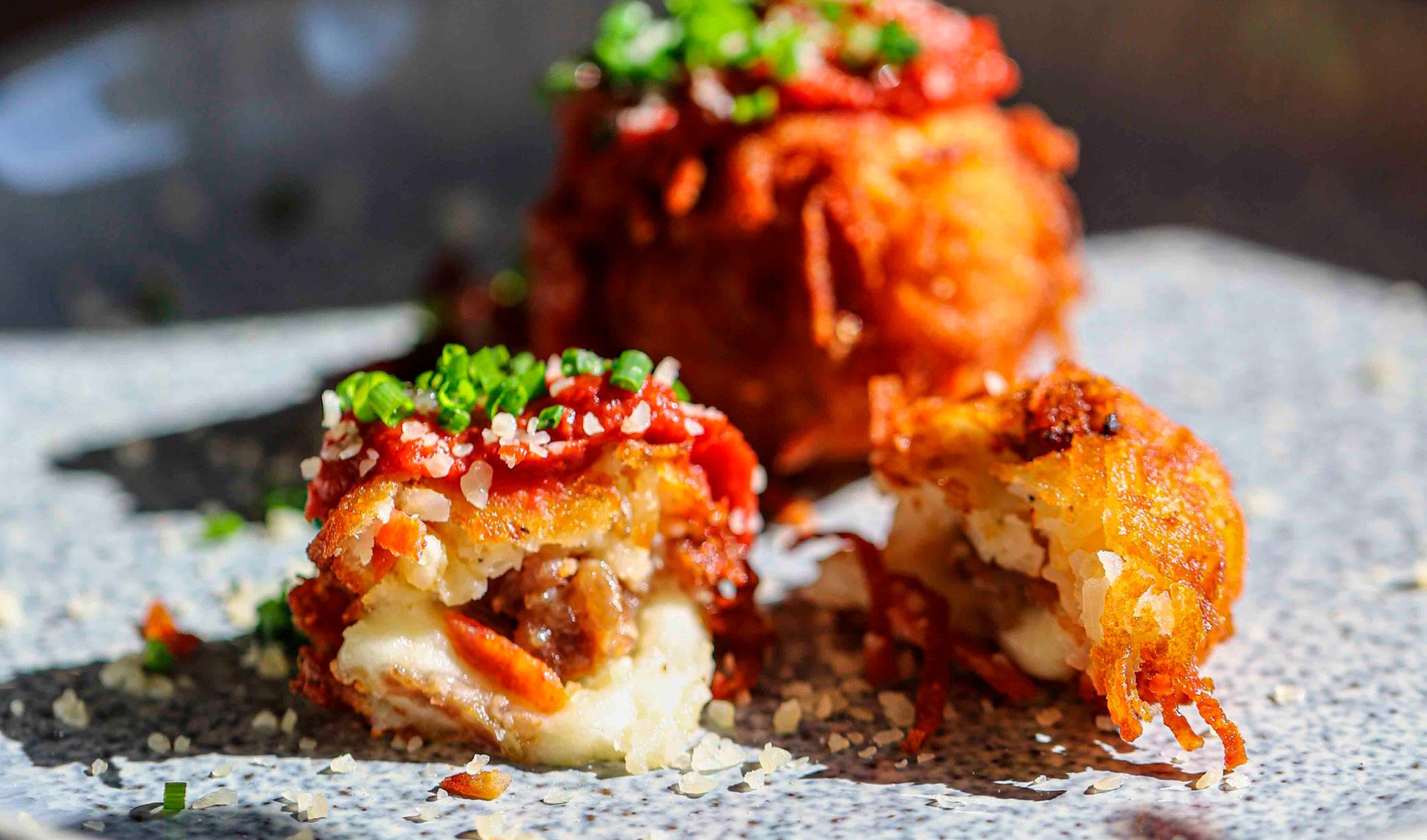
13 minute read
Management
from National Culinary Federation (Jan/Feb 2021)
by National Culinary Review (an American Culinary Federation publication)
BUILDING AN INCLUSIVE CULTURE
One ACF Chef offers tips on how to grow and diversify kitchens for the future
In addition to a global pandemic, last year brought some of the most active civil unrest this country has seen in more than 50 years. It led to some positive changes, though: Many business leaders have done more than just vow to put a greater emphasis on diversity; they are taking real, calculated steps to build a more inclusive culture.
The culinary industry — here and around the world — has certainly had its struggles when it comes to diversity and inclusion, but that has been improving in recent years, and will continue to improve as more chefs in leadership roles make equity a priority in their recruitment, training and dayto-day operations. We caught up with Chef Ashten Garrett — president of the ACF Young Chefs Club and senior culinary arts manager for Marriott International, who presented on diversity in the kitchen during a webinar last fall — for his thoughts on the topic. This interview has been edited for clarity and condensed. Q: From your perspective, what is the current state of diversity in culinary culture and kitchen operations? A: As a young chef, it can be a daunting enough task to remain motivated and inspired in environments that are continually changing every day. But adversity comes in many different forms, and for me, the most difficult adversary is the lack of diversity in the industry.
Imagine a room full of people, and the majority of them do not look like you, walk like you or speak like you. This is the case for most minority chefs and hospitality workers. Most kitchens that I have worked or spent time in have been diverse — but only to a certain extent. We navigate these spaces as “foreigners” with the hopes of being accepted. This can be intimidating, and if we are working in establishments that aren’t open to diversity and inclusion, or do not understand or recognize the significance of accepting it, it can diminish the quality of our work and performance.
I would like to say most 21st-century chefs and restaurant owners have grasped how workplace diversity brings a new perspective, energy, and quality of performance to an establishment. But unfortunately, this is not always the case. The acceptance of diversity and inclusivity sometimes veers in different directions depending on the current social and economic climate. But if we truly wish to change the narrative of this beloved and important industry, it will take more than a few posts on Facebook or a 15-minute Zoom call. It will require
immediate and consistent pressure to elucidate and eradicate the difficulties minorities face. Q: What progress has the industry made over the past few decades to be more inclusive and accepting of different backgrounds and ideas? A: I think that the advent of social media has played an integral role in the push to accept chefs who are minorities and/or women. When new voices are amplified, it sparks a call to action to accept diversification and inclusivity.
Now, some can argue that little to no progress has been made to advance inclusivity in the industry. There are still major hindrances to the progress of minorities, women, and ambitious young chefs. Women and women of color are still underrepresented and disenfranchised; young chefs are opting to pursue more entrepreneurial careers due to longstanding industry pressures and lack of acceptance; and minority voices are still being drowned out by implicit bias and systemic racism.
All of these have a direct impact on the longevity and sustainability of the culinary and hospitality industry. As the industry remains in limbo, one thing is certain: In order to evolve, we all must be willing to change, as no problem can be solved until we first recognize that there is one. Q: What areas of the culinary industry in particular are in most need of diversifying and opening up to different backgrounds, ideas, and cultures? Why? A: I think the most pivotal areas are restaurant ownership/ proprietorship, food writing, investing/funding, and the executive chef role. I think anyone can relate when I say it is more possible to summon the motivation to do something when someone who looks like you has done it or is doing it. Ownership is especially important because when you own, you have the control. Support via funding, sponsorships and endorsements for those that wish to become owners will be a game changer for the industry.
The same can be said about writers and bloggers: Those behind the keyboard and holding the pen control the narrative. When writers and bloggers do not highlight minority establishments or create opportunities for minority voices in the industry to be heard, it creates a cycle of alienation, because minorities then feel they have no voice. Consequently, that also can lead industry leaders to abandon diversity efforts, causing minorities to venture out on their own. Think of the phrase, “If you do not have a seat at the table, go and create your own.” Many minority chefs, unfortunately, have had to adopt this approach. Q: Is the traditional brigade system of a kitchen part of the problem when it comes to accepting diversity and reinforcing bias in culinary? Why? Or if not, is there anything in traditional culinary culture that impedes inclusion? A: Any great chef is a mere reflection of his/her team, as they alone cannot be successful. That said, I do not think that the brigade system is the sole issue when it comes to diversity. The brigade system’s organization and management is necessary and important in any kitchen. When service is at its busiest peak, it is important to have one or two designated leaders conducting the orchestra by directing and delegating, because too many voices and opinions (or “too many coaches and not enough players”) can create conflict and slow service.

Instead, the issue lies with the character and personality of the one who is building the culture. An establishment’s culture needs leadership, consistency, integrity, and diversity. Ask: Does this particular brigade system help create a safe, inviting, professional and nurturing work environment that is conducive to growth? Does the team feel they can freely express themselves via questions and interactions? I think that most people focus on the effect and not necessarily the cause. Q: What is your advice to the industry to help identify and remove bias and be more inclusive to all backgrounds and cultures in culinary operations?
A: My advice would be to genuinely listen, learn and be empathetic. We all have a story to tell, and cooking is an expressive craft that helps us all do that. Food knows no gender, age, race, ethnicity, or disability; it exists to be enjoyed. As chefs, we do not discount a particular cuisine or culture when we cook just because it is different or not indigenous to our own; rather, we take the courageous leap to learn more about it and explore its flavors and ingredients. Therefore, we should not discount each other, but rather accept our differences. We all have a voice and the right to explain why cooking is so important to us. Q: In your own experience of moving up in the industry from where you started to where you are today, do you have a story that illustrates the importance of an inclusive culinary environment, and the advantages of an operation that is welcoming and open-minded to diverse cultures and backgrounds? A: I have been extremely blessed to have worked in many kitchens around the world in operations that welcome and celebrate diversity. As an example, I studied abroad in Florence, Italy. I was timid and nervous about my place in an international kitchen working alongside experienced chefs, and I did not speak the language.
Prior to this experience, I had spoken with colleagues who had worked abroad and attributed their many personal and professional problems due to race and gender barriers and biases. Hearing this information amplified my uncertainty about the decision to work internationally, but I decided to stay with it. And to my amazement, the respect and acceptance I received from the very beginning was overwhelming, and subsequently made me want to perform at an even higher level. Once that barrier was broken and I felt as if I belonged, it intensified my passion and allowed me to focus on and enjoy the craft of cooking. Q: What would you say as a call to action for our industry? A: I am a firm believer we all want what is best for our industry, and that is for it to thrive, not just survive. Collectively, it will mean holding those in power accountable to drive change. There is a great quote along the lines of, “Those that have the ability also have the responsibility.” Change is internal but expressed outwardly. It demands self-exploration and genuine compassion. The current state of our industry is changing every day to deal with new demands and new clientele, as seen in the plethora of companies re-branding from problematic logos or names.
There is power in our voices, in the white coat, and in diversity. My personal call to action would be not for a bill to be passed, or for the CEO of a major company to issue a newsletter or campaign, or for companies around the world to immediately change their business models. My call to action is that we all recognize and accept there is a universal issue: the inequity of equal access to opportunity in the workforce caused by implicit bias, lack of diversity and inclusivity, and minority indifference. It will take a concerted effort and a lot of investment to lead us to a better way of operating.
If we take the time now to plant and nurture the seeds of reorientation and change, those that come after us can harvest the fruit. Much like our ancestors did when pioneering the way for us, we must leave our industry better than we found it. To cite an African proverb, “For if we wish to go fast, we will go alone, but if we wish to go far, we must go together.” To learn more about Chef Ashton, visit chefashten.com.


CHAPTER CLOSE-UP:
ACF OF KALAMAZOO/BATTLE CREEK
Today, the ACF of Kalamazoo/Battle Creek (Michigan) chapter is 30 members strong. Just four years ago, that number was seven // By Amelia Levin
Chef Eric Gillish inherited quite the challenge when he came Fundraising Success on board as president: reviving the leadership and growing This past November, the chapter hosted a sold-out, socially membership. He credits the camaraderie and collaboration distanced chef’s tasting event to raise funds for scholarships. with other Michigan ACF chapters for helping him expand the The “Seven Courses of Gold” dinner was modeled after a member base more than fourfold. previous chapter event that “originally connected me with
“We have an open-door policy with all Michigan chapters, the ACF, way before I ever considered being a member,” Chef welcoming anyone from any other chapter to attend not only Gillish says. “It was considered a big honor to be asked to our meetings, but our events as well,” says Gillish, corporate participate in this dinner, which celebrated seven courses from chef for the Millennium Restaurant Group, which operates nine seven local chefs with wine pairings, followed by the chapter’s restaurants (11, pre-COVID-19) as well as a robust catering annual awards. Unfortunately, about eight to 10 years ago, the program. “We frequently share chapter calendars, schedules, event fizzled out [due to low attendance].” event announcements and so on. Last year, Chef Gillish brought That has been a huge help for our up the idea of resurrecting the chapter to pull ideas that others are fundraising dinner, but without the doing, and vice versa.” awards, as the chapter already had an
The first thing Chef Gillish did established annual awards dinner in as president was create a schedule partnership with a new local culinary for monthly chapter meetings school. “We kept the same concept and board meetings to introduce of seven chef courses, encouraged some consistency, as well as chefs to partner with a local farmer add educational components to or vendor for their course [to drive meetings for members, to give them product donations], offered cocktail/ something of value to take away. spirits pairings using local distillers,
He also reached out to his and had two surprise student courses vendor-partners to collaborate on by local area tech center students,” he fun cooking and learning events, says. The dinner was a hit, helping the including homemade vinegar- chapter to raise $3,500, with most of making classes, charcuterie the ingredients donated. This, in turn, tastings, mushroom foraging allowed the chapter to offer its largest lessons, microbeer and artisanal scholarship yet at $1,500, plus two cheese pairings, and more. All other $1,000 scholarships. chefs, ACF members and non- “This year, even with COVID-19 members alike, were (and will and state and local restrictions, be, when events resume in the future) encouraged to attend we were able to hold the dinner with restricted capacity at to boost membership. Many events were also open to the 600 Kitchen and Bar, an amazing farm-to-table restaurant in public for a cost to foster idea-sharing, with discounts offered Kalamazoo,” Chef Gillish says. to chapter members as an incentive to attend. Members also The chapter also hosted another fundraising dinner-toreceive access to private events. go, supported by ingredient/product donations and time
Chef Eric Gillish, president of ACF Kalamzoo/Battle Creek


Left: Chef Eric Gillish, president of ACF Kalamazoo/Battle Creek, addresses his team before a recent fundraising dinner. Right: Chef Gillish at the pass at 600 Kitchen and Bar in Kalamazoo, Michigan, during the dinner.

volunteered by chefs and students, to raise money for a local chef who tragically had lost his son. “We raised between $4,000 and $5,000 for the family,” Chef Gillish says. “Even though this chef is not an ACF chef, he’s part of our community. By showing our support this way, we show that the ACF is not just a prestigious organization; it’s an organization for all chefs and their communities.”
A Bright Future
The work is not over. This summer, the chapter plans to host a membersonly catered family picnic, and Chef Gillish hopes to bring back the annual awards dinner. He also aims to continue fundraising to help other chefs in need.
“Aside from that, we have participated in local farmers market demos, and whenever possible, we try to support and work with the local ACF-accredited culinary school,” he says. “This year, we created a student chair to liaise between our chapter and their student food groups. When COVID-19 hit, I did my best to stay connected with other chapters by sharing information and simply reaching out to see how everyone was doing.”
To boost chapter membership, Chef Gillish even looked up memberships that had lapsed in the last two years and invited those chefs to attend meetings and participate with the chapter once again, and is exploring ways to subsidize membership, if need be.
“We have come a long way in four years,” he says. “All of this sounds like a lot, but sometimes it doesn't feel like enough. We are doing our best to keep our head above water, support those in need, and, unfortunately, mourn the closing of some of our local establishments due to the pandemic. That’s why it’s very important that we not only stick together, but actually help and support each other to keep our community strong.”








